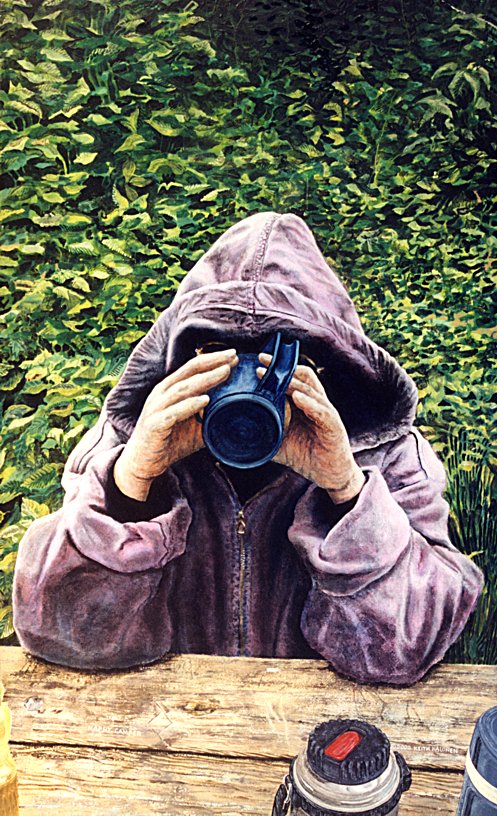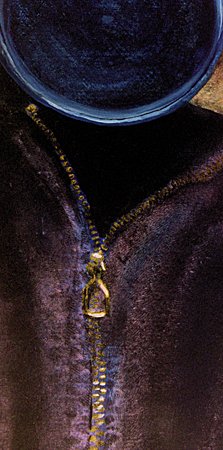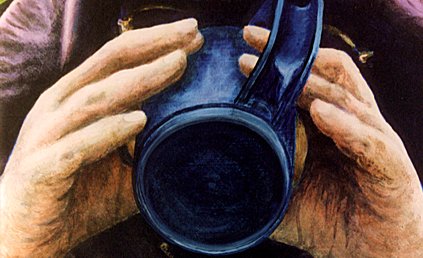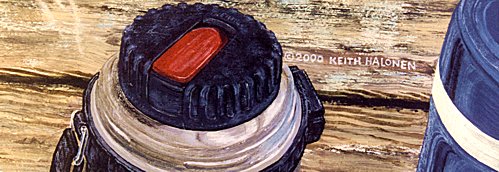|
|

|
|
HAPPY CAMPER
© 2000 Keith Halonen oil on panel 14¾×24¼ in / 38×61 cm $ 6,000 US THIS PAINTING IS A GOLDEN RECTANGLE |

|
« CLICK to contact the artist |








|
CLICK » to order this print |

|
|
YOU ARE IN THE PEOPLE PAINTINGS GALLERY
CLICK THE SHORTCUT ICONS ABOVE TO VIEW MORE PAINTINGS |
|
After crawling out of one's sleeping bag into the crisp morning light and chill air of a remote forest wilderness, few comforts better reward the outdoor enthusiast than a freshly brewed cup of Celebes Kalossi or Guatemalan Las Nubles coffee. Next comes the important task of filling the thermos jug so that other opportune moments during the camping expedition are not unnecessarily devoid of the delicious quintessential bean.
It's said coffee was originally discovered by goats shepherded by a Greek named Kaldi. He noticed that whenever the goats were grazing on a certain plant they became particularly animated, and they even occasionally seemed to dance. Kaldi ate some of the berries himself, and danced with the goats. Very few people in America really camp. For most people the idea means little more than pulling the family vehicle up next to a picnic table and then erecting a volleyball net. This is where the camper in this painting enjoys her coffee, but this particular camper is well known to the artist. I've accompanied her to the tops of mountains to bathe in natural hot springs where there were no other human beings to be seen for days on end. I've stood with her scant meters away from wild boar and great tule elk. We've weathered ferocious storms inside a tiny tent and dug our way out of it through layers of snow and frost. We've wept in tandem on arduous trails which seemed never to arrive at their destination. If she wants to enjoy some hot coffee at a picnic table next to the car every now and then, she's entitled. |

|
 
|
|
|
Detail from HAPPY CAMPER
|
|
Here again some attention to detail. The zipper provides a contrasting metallic glint from within the shadows of the coat. Reflection is another area which demands some dedication. There are subconscious aspects to the viewing of art. The fabric patterns in the curtains behind the chess player in Concentration, the drapery adorning the Diosa Nicaraguansa, and the pillow coverings in Mujer del Tatuaje are all rendered in very exacting detail. If things which are supposed to be complex appear conspicuously simple the viewer's mind senses inaccuracy.
There are painting styles which achieve convincing detail with suggestive techniques, but without masterful execution there may be insufficient visual information to satisfy the mind's demand for clutter or detail where it might be reasonably expected. Reflection, like fabric pattern, is around us always. We pay it little heed, but certainly our peripheral vision works with our subconscious minds to create an expectation of reflection. Most reflection is not the flat mirror sort, but a distorted variation such as that on the brushed steel threads of the metal thermos or the surface of the plastic thermos. Artists can employ suggestive techniques to simulate reflection, but there is some risk that important contrast relationships may be depicted antithetically. Better to make some study of the reflection in each individual case where it occurs. |
———————— GALLERIES ————————









|